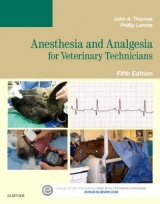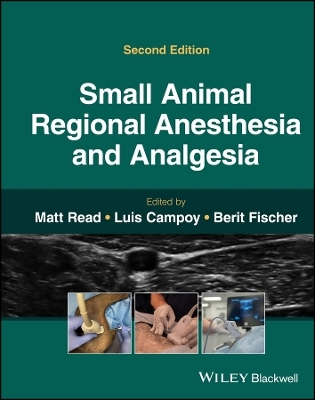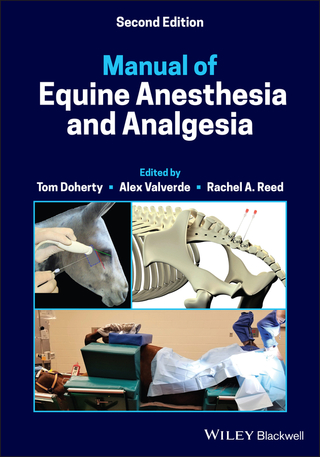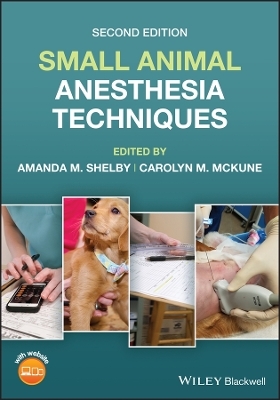
Anesthesia and Analgesia for Veterinary Technicians
Mosby (Verlag)
978-0-323-05504-8 (ISBN)
- Titel erscheint in neuer Auflage
- Artikel merken
This guide to the principles of anesthesia administration in animals�combines user-friendly coverage of essential information with an outstanding illustration program and improved readability. Anesthesia and Analgesia for Veterinary Technicians, 4th Edition prepares you to administer anesthesia with information on pre-anesthetic preparation of the patient, induction procedures, monitoring animals' vital signs during the anesthetic period, and postoperative care. Expert authors John A. Thomas, DVM, and Phillip Lerche, BVSc PhD, Dipl ACVA, also include discussions of actions and side effects of anesthetic agents, the physiology of respiration, heart rate and blood pressure, emergency response, anesthetic equipment, and specialized techniques.
.
Comprehensive scope of coverage includes both large and small animals.
A reading level and depth of information appropriate for the technical level.
Easy-to-read, user-friendly format makes this a practical guide in the classroom or in practice.
Objectives, key points, and review questions help reinforce learning.
Focus on health and safety issues satisfies OSHA requirements.
Step-by-step procedures boxes clarify the technician's role in anesthesia delivery.
New organization and completely updated techniques, drugs, and equipment keep you up-to-date on the latest advances in the field.
49 new procedures boxes, 20 anesthetic protocol boxes, and 5 case studies help you apply knowledge to real-life situations.
Two new large animal chapters cover pain management and anesthetic techniques for equine and ruminant patients.
Illustrated, step-by-step procedures and the full-color format make this text inviting and user-friendly.
All new figures and 4-color art make the material easy to understand and visually appealing.
New material in every chapter incorporates the expanding role of veterinary technician anesthetists, especially in referral practices, teaching institutions, and research.
Chapter outlines and Technician Tips emphasize key information and highlight key terms in the glossary.
Student resources on the Evolve website include a video animation that demonstrates the use and maintenance of different anesthesia machines.
Introduction to Anesthesia History of anesthesia
The Veterinary Technician's Role in the Practice of Anesthesia
Patient Preparation
Communication-A Key to Success
The Minimum Patient Database
Patient History
Physical Examination and Physical Assessment
Preanesthetic Diagnostic Workup
Determination of the Physical Status Classification
Selection of the Anesthetic Protocol
Preinduction Patient Care
Withholding Food before Anesthesia
Patient Stabilization
Intravenous Catheterization
Reasons for Intravenous Catheterization
Choosing and Placing an Intravenous Catheter
Fluid administration
Composition of Body Fluids
Fluid Homeostasis
Fluid Needs
Classification of IV Fluids
IV Fluid Selection and Administration Rates
Adverse Effects of Fluid Administration
Calculating Fluid Administration Rates
Other Preanesthetic Care
Anesthetic Agents and Adjuncts
Introduction to Anesthetic Agents and Adjuncts
Agonists, Partial Agonists, Mixed Agonist-Antagonists, and Antagonists
Analgesic Effects of Anesthetics and Adjuncts
Using drugs in combination
Regulatory Considerations for Controlled Substances
Preanesthetic Medications
Reasons for the use of preanesthetic medications
Anticholinergics
Tranquilizers and Sedatives
Opioids
Neuroleptanalgesia
Opioid Antagonists
Injectable Anesthetics
Barbiturates
Propofol
Dissociative anesthetics
Etomidate
Guaifenesin.
Inhalation Anesthetics
Classes of Inhalation Agents
CNS and Respiratory Stimulants
Doxapram
Anesthetic Equipment
Endotracheal Tubes and Associated Equipment
Endotracheal tube parts
Laryngoscopes
Masks
Anesthetic Chambers
Anesthetic Machines
Components of the Anesthetic Machine
Rebreathing Systems
Non-rebreathing Systems
Operation of the Anesthetic Machine
Care and Maintenance of Anesthetic Equipment
Anesthetic Monitoring
Introduction to Monitoring
Stages and Planes of Anesthesia
Overview of Anesthetic Stages and Planes
Finding the Optimum Depth
Determining whether or not the Patient is Safe
Indicators of Circulation
Heart rate
Heart rhythm
Capillary refill time
Blood Pressure
Pulse strength
Indicators of Oxygenation
Mucous membrane color
Physiology of Oxygen transport
Pulse Oximeter
Blood Gas Analysis
Indicators of Ventilation
Respiratory rate
Tidal volume
Respiratory Character
Apnea monitor
Capnograph (End-tidal CO2 monitor)
Blood gas analysis
Indicators of Body Temperature
Assessment of Anesthetic Depth
Reflexes and Other Indicators of Anesthetic Depth
Judging Anesthetic Depth
Recording Information during Anesthesia
Special Techniques
Local anesthesia
Local anesthetic agents
Characteristics of local anesthetics
Mechanism of Action
Route of Administration of Local Anesthetics
Toxicity of Local Anesthetics
Assisted and controlled ventilation
Ventilation in the Awake Animal
Ventilation in the Anesthetized Animal
Types of Controlled Ventilation
Risks of Controlled Ventilation
Neuromuscular blocking agents
Analgesia
Physiology of pain
Consequences of untreated pain
Signs of pain in animals
Pain assessment tools
Assessing response to therapy
Perioperative pain management
Pharmacologic analgesic therapy
Opioid Agents
Nonsteroidal Antiinflammatory Drugs
Other Analgesic Agents
Multimodal Therapy
Home Analgesia
Nursing care
Non-pharmacologic therapies
Canine and Feline Anesthesia
Patient Preparation
Selecting a Protocol
Summary of a General Anesthetic Procedure
Anesthetic induction with an IM agent or combination
Anesthetic induction with an IV injection of an ultra-short acting agent to effect
Total Intravenous Anesthesia (TIVA) by IV boluses of an ultra-short acting agent
Total Intravenous Anesthesia (TIVA) by constant rate infusion (CRI)
Induction and maintenance with an inhalant agent
IV induction and maintenance with an inhalant agent
Equipment Preparation
Premedication or Sedation
Anesthetic Induction
IV Induction
Inhalation Agents
Mask Induction
Chamber Induction
IM Induction
Oral administration
Endotracheal Intubation
Equipment for Endotracheal Intubation
Selecting an Endotracheal Tube
Preparing the Tube
Intubation Procedure
Checking for Proper Placement
Securing the Tube
Cuff inflation
Laryngospasm
Complications of Intubation
Maintenance of Anesthesia
Maintenance with an Inhalant Agent
Maintenance with repeat boluses of propofol or other ultrashort-acting agent
Maintenance with a CRI
Maintenance with injectable and inhalant agents
Maintenance with an IM injection
Patient Positioning, Comfort and Safety
Anesthetic Recovery
Anesthetist's Role in the Recovery Period
Signs of Recovery
Monitoring
Oxygen Therapy
Extubation
The Postanesthetic Period
Equine Anesthesia
Patient Preparation
Selecting a Protocol
Summary of a General Anesthetic Procedure
Equipment Preparation
Premedication or Sedation
Standing chemical restraint
Anesthetic Induction
IV Induction
Inhalation Induction via Nasotracheal Tube
Endotracheal Intubation
Equipment for Endotracheal Intubation
Selecting an Endotracheal Tube
Preparing the Tube
Intubation Procedure
Complications of Intubation
Maintenance of Anesthesia
Maintenance with an Inhalant Agent
Maintenance with intravenous agents, or TIVA
Maintenance with injectable and inhalant agents
Patient Positioning, Comfort and Safety
Anesthetic Recovery
Preparation for recovery
Monitoring during recovery
Signs of recovery
Extubation
Standing after regaining consciousness
The Postanesthetic Period
Food Animal Anesthesia
Ruminants
Patient preparation
Selecting a Protocol
Summary of a General Anesthetic Procedure
Equipment Preparation
Premedication or Sedation
Anesthetic Induction
Endotracheal Intubation
Maintenance of Anesthesia
Patient Positioning, Comfort and Safety
Anesthetic Recovery
The Post-anesthetic Period
Swine
Physical examination
Sedation
Anesthetic Induction
Maintenance of Anesthesia
Recovery
Anesthesia of Rodents and Rabbits
Patient evaluation
Handling and restraint
Physical examination
Diagnostic tests
Preanesthetic patient care
Withholding food
Correction of preexisting problems
Preanesthetic agents
Anticholinergics
Phenothiazines
Benzodiazepines
Alpha2 adrenergic agonists
Opioids
General anesthesia
Induction techniques and agents
Intubation and maintenance of anesthesia
Postoperative care
Anesthetic emergencies
Respiratory depression
Circulatory failure
Postoperative Analgesia
Pain assessment
Analgesic agents
Chronic pain
Administration of analgesics
Anesthetic Problems and Emergencies
Reasons That Anesthetic Problems and Emergencies Arise
Human Errors That May Lead to Anesthetic Problems and Emergencies
Equipment Issues That May Lead to Anesthetic Problems and Emergencies
Adverse Effects of Anesthetic Agents
Patient Factors that may lead to Anesthetic Problems and Emergencies
Response to Anesthetic Problems and Emergencies
Role of the Veterinary Technician in Emergency Care
General Approach to Emergencies
Emergency Situations That May Arise During Anesthesia
Problems That May Arise in the Recovery Period
Workplace Safety
Hazards of Waste Anesthetic Gas
Short-Term Effects
Long-Term Effects
Assessment of Risk
Reducing Exposure to Waste Anesthetic Gas
Anesthetic techniques and procedures
Monitoring Waste Gas Levels
Safe Handling of Compressed Gases
Fire Safety Precautions
Use and Storage of Compressed Gas Cylinders
Accidental Exposure to Injectable Agents
� Glossary
| Reihe/Serie | evolve |
|---|---|
| Zusatzinfo | Approx. 580 illustrations (576 in full color) |
| Verlagsort | St Louis |
| Sprache | englisch |
| Themenwelt | Veterinärmedizin ► Klinische Fächer ► Anästhesie / Intensivmedizin |
| ISBN-10 | 0-323-05504-4 / 0323055044 |
| ISBN-13 | 978-0-323-05504-8 / 9780323055048 |
| Zustand | Neuware |
| Informationen gemäß Produktsicherheitsverordnung (GPSR) | |
| Haben Sie eine Frage zum Produkt? |
aus dem Bereich



